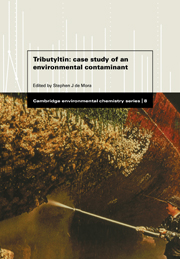Book contents
- Frontmatter
- Contents
- Contributors
- Preface
- 1 The tributyltin debate: ocean transportation versus seafood harvesting
- 2 Industrial manufacture and applications of tributyltin compounds
- 3 The analysis of butylated tin compounds in the environment and in biological materials
- 4 The occurrence, fate and toxicity of tributyltin and its degradation products in fresh water environments
- 5 The distribution and fate of tributyltin in the marine environment
- 6 Biological effects of tributyltin on marine organisms
- 7 TBT-induced imposex in neogastropod snails: masculinization to mass extinction
- 8 Environmental law and tributyltin in the environment
- 9 The efficacy of legislation in controlling tributyltin in the marine environment
- Index
5 - The distribution and fate of tributyltin in the marine environment
Published online by Cambridge University Press: 04 August 2010
- Frontmatter
- Contents
- Contributors
- Preface
- 1 The tributyltin debate: ocean transportation versus seafood harvesting
- 2 Industrial manufacture and applications of tributyltin compounds
- 3 The analysis of butylated tin compounds in the environment and in biological materials
- 4 The occurrence, fate and toxicity of tributyltin and its degradation products in fresh water environments
- 5 The distribution and fate of tributyltin in the marine environment
- 6 Biological effects of tributyltin on marine organisms
- 7 TBT-induced imposex in neogastropod snails: masculinization to mass extinction
- 8 Environmental law and tributyltin in the environment
- 9 The efficacy of legislation in controlling tributyltin in the marine environment
- Index
Summary
Introduction
Earlier chapters have outlined the extensive usage of tributyltin (TBT) in marine antifouling paints which commenced in Europe around 1960, almost a decade after its biocidal properties were first reported (Bennett, 1983). Almost 30 years later it has been banned from use on small craft, to protect shellfish, such as oysters, mussels and scallops, and gastropods, from its impacts in confined waterways. The legacy of the unknown quantities of TBT that have leached from many square kilometres of painted surfaces in waters worldwide, has been that sediments in the vicinity of marinas, dockyards, wharves and other areas of high boating activity now contain measurable concentrations of TBT. This derives not only from paint scrapings, but from the preferential partitioning of dissolved TBT onto colloidal and particulate surfaces, which ultimately accumulate in bottom sediments. Once resident here, the concern is for its availability to sediment-dwelling biota, and its potential remobilisation to overlying waters.
There has been extensive research into the fate of TBT in the marine environment, and this has been reviewed by a number of authors (e.g. Laughlin & Linden, 1985; Clark, Sterritt & Lester, 1988; Muller, Renberg & Rippen, 1989; Stewart & de Mora, 1990). This includes degradation and removal processes in the water column and in sediments, as well as biotic transformations. Reactions will involve adsorption, photolysis, and both microbial and abiotic decomposition processes.
- Type
- Chapter
- Information
- TributyltinCase Study of an Environmental Contaminant, pp. 139 - 166Publisher: Cambridge University PressPrint publication year: 1996
- 35
- Cited by



